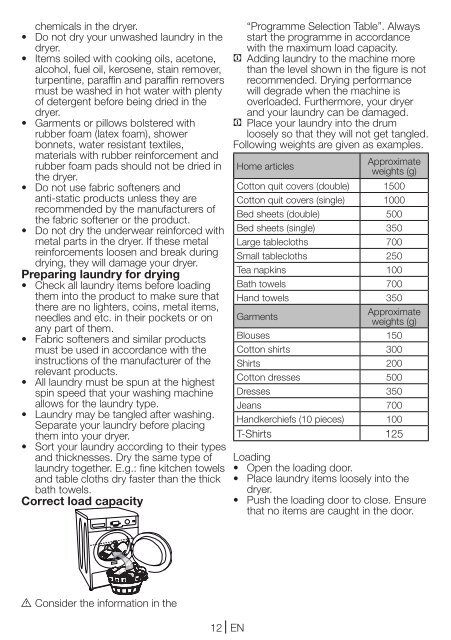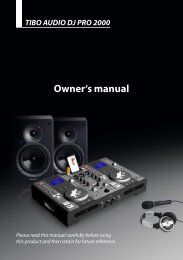You also want an ePaper? Increase the reach of your titles
YUMPU automatically turns print PDFs into web optimized ePapers that Google loves.
chemicals in the dryer.<br />
• Do not dry your unwashed laundry in the<br />
dryer.<br />
• Items soiled with cooking oils, acetone,<br />
alcohol, fuel oil, kerosene, stain remover,<br />
turpentine, paraffin and paraffin removers<br />
must be washed in hot water with plenty<br />
of detergent before being dried in the<br />
dryer.<br />
• Garments or pillows bolstered with<br />
rubber foam (latex foam), shower<br />
bonnets, water resistant textiles,<br />
materials with rubber reinforcement and<br />
rubber foam pads should not be dried in<br />
the dryer.<br />
• Do not use fabric softeners and<br />
anti-static products unless they are<br />
recommended by the manufacturers of<br />
the fabric softener or the product.<br />
• Do not dry the underwear reinforced with<br />
metal parts in the dryer. If these metal<br />
reinforcements loosen and break during<br />
drying, they will damage your dryer.<br />
Preparing laundry for drying<br />
• Check all laundry items before loading<br />
them into the product to make sure that<br />
there are no lighters, coins, metal items,<br />
needles and etc. in their pockets or on<br />
any part of them.<br />
• Fabric softeners and similar products<br />
must be used in accordance with the<br />
instructions of the manufacturer of the<br />
relevant products.<br />
• All laundry must be spun at the highest<br />
spin speed that your washing machine<br />
allows for the laundry type.<br />
• Laundry may be tangled after washing.<br />
Separate your laundry before placing<br />
them into your dryer.<br />
• Sort your laundry according to their types<br />
and thicknesses. Dry the same type of<br />
laundry together. E.g.: fine kitchen towels<br />
and table cloths dry faster than the thick<br />
bath towels.<br />
Correct load capacity<br />
“Programme Selection Table”. Always<br />
start the programme in accordance<br />
with the maximum load capacity.<br />
C Adding laundry to the machine more<br />
than the level shown in the figure is not<br />
recommended. Drying performance<br />
will degrade when the machine is<br />
overloaded. Furthermore, your dryer<br />
and your laundry can be damaged.<br />
C Place your laundry into the drum<br />
loosely so that they will not get tangled.<br />
Following weights are given as examples.<br />
Home articles<br />
Approximate<br />
weights (g)<br />
Cotton quit covers (double) 1500<br />
Cotton quit covers (single) 1000<br />
Bed sheets (double) 500<br />
Bed sheets (single) 350<br />
Large tablecloths 700<br />
Small tablecloths 250<br />
Tea napkins 100<br />
Bath towels 700<br />
Hand towels 350<br />
Garments<br />
Approximate<br />
weights (g)<br />
Blouses 150<br />
Cotton shirts 300<br />
Shirts 200<br />
Cotton dresses 500<br />
Dresses 350<br />
Jeans 700<br />
Handkerchiefs (10 pieces) 100<br />
T-Shirts 125<br />
Loading<br />
• Open the loading door.<br />
• Place laundry items loosely into the<br />
dryer.<br />
• Push the loading door to close. Ensure<br />
that no items are caught in the door.<br />
A Consider the information in the<br />
12 EN






